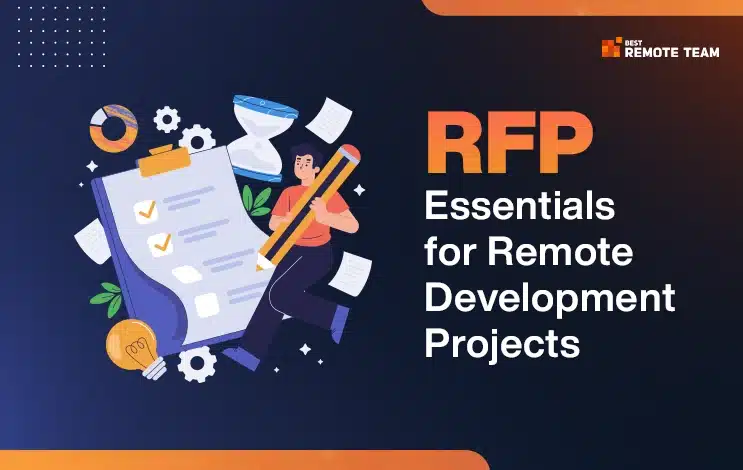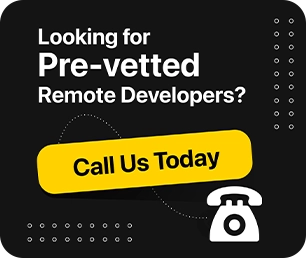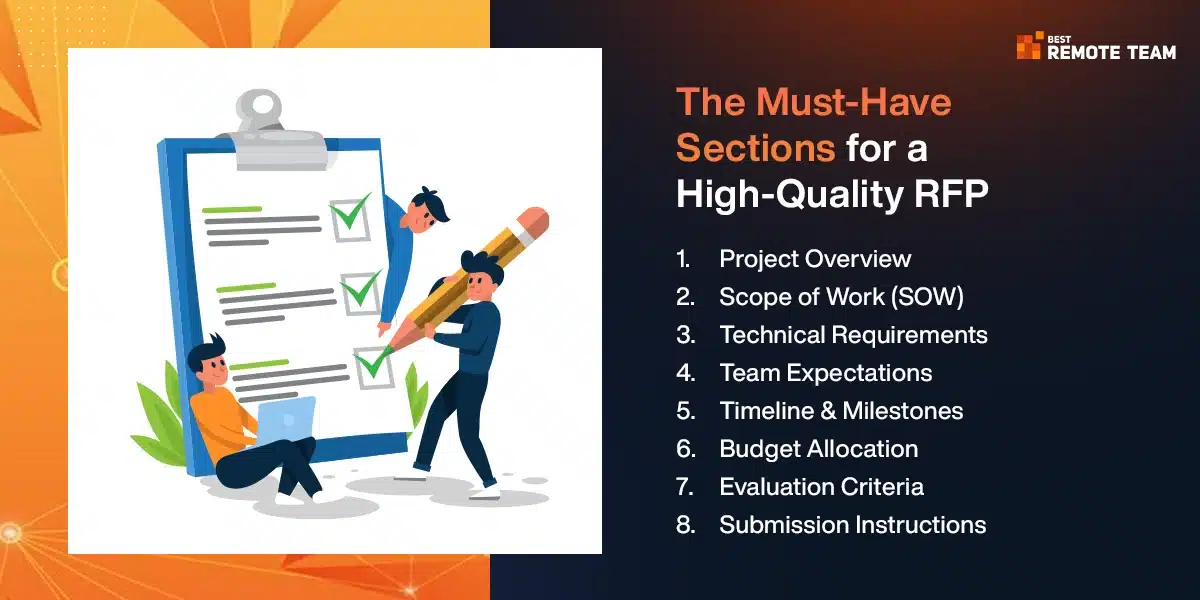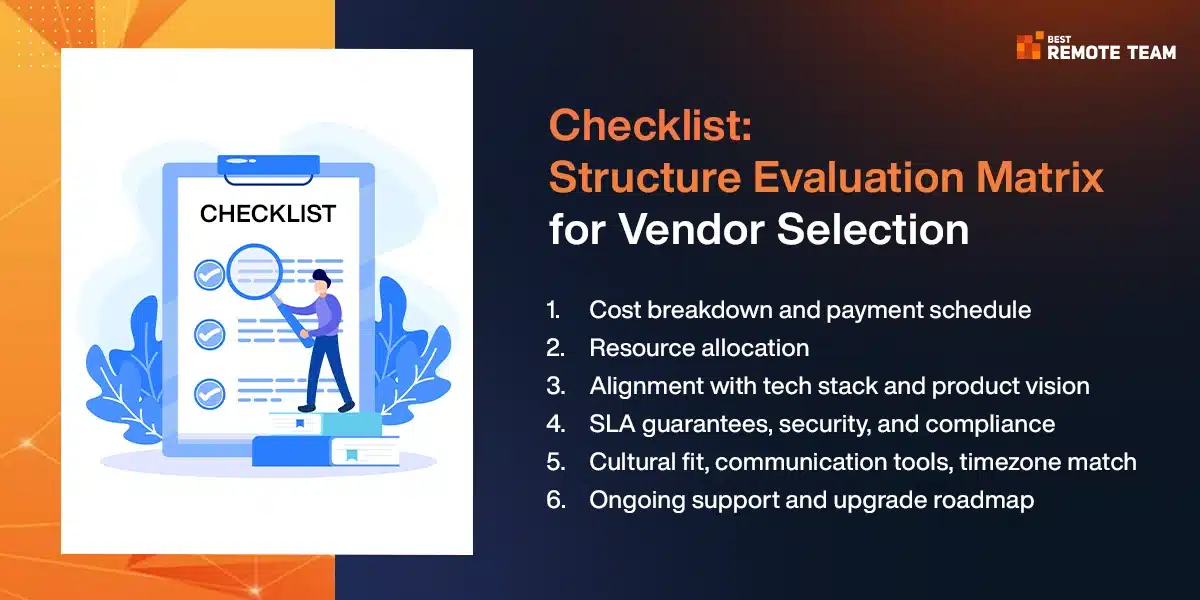What is an RFP and why does it matter for Large-Scale Remote Development Projects?
RFP (Request for Proposal) is a document that is submitted by a business, including every detail of the project, to give a clear picture of the project requirements and project goals.
RFP is usually created by the business or enterprise and sent to IT companies or vendors when they need external IT services or need to hire remote developers.
The main purpose of an RFP is to give clarity between a business and a remote development company.
It gives vendors a clear picture of what the project is about, its goals, requirements, budget, and timelines, so they can propose the best solution.
RFP is a crucial document, especially when you are handling a large-scale project, because it usually needs multiple stakeholders and bigger budgets.
A detailed RFP will give a clear roadmap to project managers, developers, and everyone in the team to prevent costly mistakes and align best with project goals.
Here are the common mistakes you must keep in mind when creating an RFP for remote vendors:
- Not specifying technical needs or integration requirements.
- Skipping budget guidelines or timeline expectations.
- Overlooking communication and reporting processes in remote setups.
- Focusing only on cost instead of long-term value and expertise.
- Setting unrealistic project timelines.
- Writing unclear or incomplete details that leave a space for assumption.
- Poor formatting and presentation of requirements.
- Avoiding compliance and security factors.
When Should You Issue an RFP Instead of a Quote or Inquiry?
The majority of people get confused between the terms RFP, RFQ and RFI as the names and sounds are quite similar.
But each serves a very different purpose in the vendor selection process. It’s important to clear the difference between RFP, RFQ and RFI and know when to use which document to get the right responses from potential partners.
Here’s a quick and small comparison table.
| Document | Purpose | When to use | What do you get by this |
| RFI( request for information) | To gather general information about vendors, solutions, or the market | Early stage, when exploring options or want information about product but not ready to buy. | Market insights, vendor capabilities |
| RFQ(request for quotation) | To request specific pricing for clearly defined requirements | When you are clear about the requirements and have finalized the choice. | Price quotes, cost comparisons. |
| RFP(request for proposal) | It’s a direct and formal doc outlining project goals, scope, and expectations for detailed vendor proposals | For complex, large-scale, multi-phase, or long-term projects. When you need to analyze various factors. | Full proposals covering approach, timeline, pricing, and expertise |
Scenarios Where an RFP Is the Right Choice?
Whether you need RFP, RFI, or RFQ, it all depends on the nature of your project. But if you are handling large-scale projects, then RFP is an important thing. Below are the scenarios when you must choose RFP for software development:
- Multi-Phase Projects: if you are planning to deliver your project in multiple stages, like MVP, beta version,and then final product build. A clear RFP can help you execute multiple stages as you planned.
- Multi-Region Deployments: If your solution is to be used across different countries or regions (e.g., a global eCommerce platform), an RFP can help evaluate vendors on compliance, scalability, and localization.
- Long-Term Partnerships: if your project needs continuous updates and support, RFP will help to analyze cost, expertise, reliability and other relevant factors.
Other than this, if you know the requirements but don’t have expertise, then RFP can help you as a record where you can mention each detail.
It can help fulfill your creative solution needs even if you don’t have in-house expertise available.
RFP can be your friend in need who will help you in the vendor shortlist process.
By collecting detailed proposals, you can compare proposals side by side and select the best remote development company based on value, not just price.
Must-Have Sections in a High-Quality RFP for Remote Development Companies
RFP requires detailed research. You must be clear with the requirements and all minor needs of the project from your side first, then only you can create a good RFP for vendors. RFP can differ from company to company, but what matters is that you convey your project requirements in clear way.
According to Best Remote Team Experts, here are the sections you must include to create a high-quality RFP.
#1. Project Overview
Here you need to describe vision, goals, business goals, problem you are trying to solve. What is your idea behind creating this project, expected results, preferred technologies, future plans, and many other things? Try to be as specific as you can; this will create a strong base from the start and avoid misunderstanding later.
#2. Scope of Work (SOW)
The scope section includes all the details like project infrastructure, product requirements, project management requirements, functional design, development, modules, integrations, features, QA, and much more.
This section can get lengthy, but the more detailed, the better. Also include risk management, change management process, approach you prefer for QA, team structure, communication and whatever is related to your software.
#3. Technical Requirements
Figure out all the technical requirements and mention preferred tech stacks, architecture guidelines, hosting, cloud needs, or security protocols.
This helps filter vendors with the right skills. Also, mention if you prefer scalability and flexibility in software.
#4. Team Expectations
Write what kind of teams you prefer for your project. Whether you need a full dedicated team, a few key roles, or just an extension temporarily to extend your in-house team.
Also mention if you plan to collaborate for a long-term or short-term project work, this will cut down your cost up to a great extent.
#5. Timeline & Milestones
Share your project timeline, key phases, and how you want the work to get delivered, like sprint-based or fixed milestones. You can mention the following details in your RFP.
- RFP publication
- Last date to answer
- T&C for consideration of application
- Vendor final date
- Expected date to start project
Also, allow enough time for companies to analyze and answer. Asking for the above details will make sure only serious companies interact with you.
#6. Budget Allocation
Budget allocation is a crucial part of the RFP and you must be honest in explaining this section. Write what you want from this project and why you are investing in this software development.
Mention your funding stage if you are a startup, series A, or enterprise level. This will give the vendor an idea about your financial position.
Mention what payment structure you prefer, like milestone-based payments tied to deliverables, monthly retainers, or phase-wise billing.
#7. Evaluation Criteria
Clarify how you will evaluate and measure proposals, such as relevant experience, scalability, or post-launch support. Share your selection criteria transparently, how you will shortlist and what type of vendors matter to you.
#8. Submission Instructions
Lastly, guide vendors step-by-step instructions on how they should respond to the proposal.
Guide proposal format, deadlines, and the mandatory fields, contact points, like how and whom they can contact.
Clearly list what their proposal should include, the format you prefer(PDF, slide deck) the deadline for submission.
You can attach the sample RFP you prefer to give them a clear idea.
What Enterprise Buyers Look For in Remote Development Proposals?
Here are the things that enterprise buyers check in proposals. Let’s go through them in brief.
#1. Prior Experience with Large-Scale Projects
Enterprise buyers will check the proof through case studies, success stories, and portfolio to see if you have done big projects earlier.
They may ask previous clients or references to see the credibility and real-world experiences.
#2. Support for Long-Term Retainer or Managed Service Models
Large-scale projects are usually ongoing and need continuous support and updates.
So, mostly they will look for someone who can work on a long-term basis to ensure the product continues to perform well.
#3. Agile Delivery Process and Integration with Client Teams
The Agile process has been the go-to process of most enterprises to get expected results.
They want vendors who can adapt through agile methods, run sprints, and collaborate closely with their internal teams.
#4. Post-Launch Maintenance, Testing and CI/CD Readiness
Technologies are evolving day by day, hence buyers will look for reliable maintenance, testing, and continuous integration/continuous delivery (CI/CD).
You must be good at bug fixing and solving sudden issues to keep the product running fine.
#5. Ability to Scale the Team Quickly for Expansion or The Next Phase
You must have strong connections and a reputation to extend the team when in need. Buyers will also look for the future if you have a specialized resource or developer accessible.
How to Structure an Evaluation Matrix for Vendor Selection?
Proposals may look the same for most companies and everyone will promise great results. So here is the evaluation matrix you should consider for vendor selection.
#1. Cost Breakdown and Payment Schedule
See how they have divided costs for design, development, testing and maintenance.
Ask for a clear payment schedule, like milestone-based payments, so you know exactly when and why money is due.
#2. Resource Allocation
An experienced team is key to a successful project, so analyze who will be working on your project: a senior or junior developer.
You should be aware of who are designers, QA testers and project managers working on the project.
#3. Alignment with Tech Stack and Product Vision
Vendors’ expertise must match your business goals.
Check if they are comfortable using your chosen technologies, cloud, frameworks or integrations.
#4. SLA Guarantees, Security and Compliance
You can afford any risks in large-scale projects, so ask about Service Level Agreements (SLAs).
These define uptime guarantees, bug-fix timelines, and response times.
Also, confirm their security practices and compliance with standards like GDPR, HIPAA, or ISO.
#5. Cultural Fit, Communication Tools and Timezone Match
Vendor must fit in your cultural, communication style, and time zone compatibility.
This is important to avoid confusion and carry out the project smoothly.
#6. Ongoing Support and Upgrade Roadmap
Most of the reputable vendors offer ongoing support in big projects, but it’s better to discuss this:
- Ask them what is the duration of ongoing support?
- Is it free, or are there any charges included?
Red Flags to Watch When Reviewing Remote Development Proposals
Choosing the right remote development partner is a big decision; hence, you must know red flags and things to avoid while you review. Here is the quick checklist:
- If their response sounds Vague or overly generic.
- If there are no details about security or compliance.
- There is no commitment to milestones or a timeline.
- If they did not mention post-launch support or maintenance.
- No backup or replacement for the developer or resources.
RFP Case Study: How Best Remote Team Developed a Fintech Product Within a Year with an RFP?
A leading fintech company approached us to develop a fintech product and mentioned they need to launch it urgently within a year.
Our team thoroughly studied their RFP, which mentioned strict compliance needs, fast delivery, and scalability.
Our senior team responded with a detailed proposal with all the necessary details and according to their preferred format.
After a detailed requirement study, we proposed a dedicated team of senior developers, QA testers, and a project manager, with flexible scaling options.
We delivered a sprint demo every two weeks, gathered feedback, and adjusted according to the feedback.
We implemented security-first architecture, easy integrations and compliance checks to meet regulatory demands.
We keep on updating the milestones on Slack and Jira to make sure the client is updated with every stage of the project.
Best Remote team launched the fintech product in multiple regions within a year, as expected.
The product performed great and easily handles thousands of transactions daily without downtime.
Lastly, here are the sweet words by our clients:
They weren’t just vendors, they were part of our team. – indusind bank
Why Enterprises Choose BestRemoteTeam as Their Preferred Outsourcing Partner?
Best Remote Team has supported some of the leading businesses across the globe as the outsourcing partner.
With 14 years of strong experience in the remote development industry, we are experts in handling RFPs and tenders. Being a trusted remote development company, we have a certified team of QA, DevOps and solution architects who understand the importance of timely responding to proposals and priority projects.
We believe in justifying quality through cost, hence we have flexible engagement models such as fixed scope, retainer, or team extension to freely choose whatever fits you best.
Plus, we also offer long-term support and help you with updates and bug fixes to ensure your long-term growth.
How to Submit an RFP to the Best Remote Team?
If you are thinking of sending an RFP to Best Remote Team, but are concerned that it might be a lengthy process.
Then don’t worry. We have a straight and simple process. Here is how you can submit an RFP to us:
- Go to our Contact page on the website.
- Enter your name, work email, and company (if any).
- Paste your RFP URL (PDF/Doc) or a short project brief. You can also paste key points in the message box.
- Share the Basics like goals, timeline, budget range, tech stack (if known), and any must-have features.
- If you need an NDA, say so, we’ll send one before reviewing files.
- Submit and you will receive a tailored proposal, with date and estimated delivery. If we need clarity, we’ll schedule a quick 15 to 20-minute call first.
Conclusion
It’s better to know what details to include in your RFP because you never know when opportunities will knock on your door.
Hope you might have learned about the essential details to include in RFP, when to use what, and the factors to consider and signs to avoid while reviewing proposals.
After all, no company is an all-rounder; it’s just about spending time and effort in finding the right remote development company that understands your goals, business problems, fits in your culture, aligns with your time zone, communication and other things.
Lastly, prioritize quality over price.






